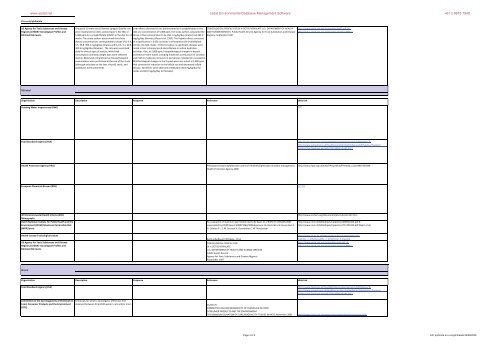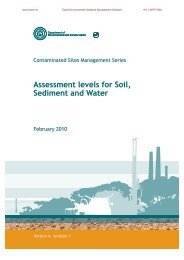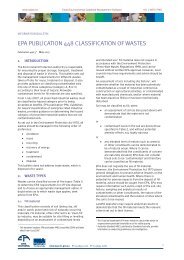Soil Generic Assessment Criteria for Human Health Risk ... - ESdat
Soil Generic Assessment Criteria for Human Health Risk ... - ESdat
Soil Generic Assessment Criteria for Human Health Risk ... - ESdat
You also want an ePaper? Increase the reach of your titles
YUMPU automatically turns print PDFs into web optimized ePapers that Google loves.
www.esdat.net Esdat Environmental Database Management Software +61 2 8875 7948<br />
Di-n-octyl phthalate<br />
US Agency <strong>for</strong> Toxic Substances and Disease<br />
Registry (ATSDR) Toxicological Profiles and<br />
Minimal <strong>Risk</strong> levels<br />
Groups of 10 male and 10 female Sprague-Dawley rats<br />
were maintained on diets containing 0, 5, 50, 500, or<br />
5,000 ppm di-n-octylphthalate (DNOP) in the diet <strong>for</strong> 13<br />
weeks. The study authors determined that these<br />
dietary concentrations corresponded to doses of 0, 0.4,<br />
3.5, 36.8, 350.1 mg/kg/day (males) and 0, 0.4, 4.1, 40.8,<br />
402.9 mg/kg/day (females). The rats were examined<br />
daily <strong>for</strong> clinical signs of toxicity, while food<br />
consumption and body weight data were collected<br />
weekly. Blood and comprehensive histopathological<br />
examinations were per<strong>for</strong>med at the end of the study<br />
(although only data on the liver, thyroid, testis, and<br />
epididymis were presented).<br />
Liver effects observed in rats administered di-n-octylphthalate in the<br />
diet at a concentration of 5,000 ppm; the study authors calculated the<br />
doses at this concentration to be 350.1 mg/kg/day (males) and 402.9<br />
mg/kg/day (females) (Peon et al. 1995). The hepatic effects consisted<br />
of a significant (p < 0.05) increases in ethoxyresorufin-0-deethylase<br />
activity (12-fold, males; 3-fold, females); no significant changes were<br />
noted in liver aminopyrine-N-demethylase or aniline hydrolase<br />
activities. Also, at 5,000 ppm, histopathological changes in hepatic<br />
architecture were noted, including moderate accentuation of zonation<br />
and mild-to-moderate increases in perivenous cytoplasmic vacuolation.<br />
Mild histological changes in the thyroid were also noted at 5,000 ppm<br />
that consisted of reduction in the follicle size and decreased colloid<br />
density. No effects were observed at 500 ppm (36.8 mg/kg/day <strong>for</strong><br />
males and 40.8 mg/kg/day <strong>for</strong> females).<br />
TOXICOLOGICAL PROFILE FOR DI-n-OCTYLPHTHALATE U.S. DEPARTMENT OF HEALTH<br />
AND HUMAN SERVICES. Public <strong>Health</strong> Service Agency <strong>for</strong> Toxic Substances and Disease<br />
Registry, September 1997<br />
http://www.atsdr.cdc.gov/toxprofiles/tp95.pdf (&<br />
http://www.atsdr.cdc.gov/mrls/index.html <strong>for</strong> MRLs)<br />
TDI inhal<br />
Organisation<br />
Drinking Water Inspectorate (DWI)<br />
Description Response Reference Web link<br />
<br />
Food Standards Agency (FSA)<br />
http://www.food.gov.uk/foodlabelling/packagingbranch/phthalates/ &<br />
http://www.eatwell.gov.uk/healthissues/factsbehindissues/phthalates/lang=en<br />
& http://cot.food.gov.uk/pdfs/TOX-2004-14.pdf SCF (<br />
<strong>Health</strong> Protection Agency (HPA)<br />
Phthalates (Diisononylphthalate and Di(2-ethylhexyl)phthalate) Incident management,<br />
<strong>Health</strong> Protection Agency 2008<br />
http://www.hpa.org.uk/web/HPAwebFile/HPAweb_C/1194947324949<br />
European Chemicals Bureau (ECB)<br />
<br />
IPCS Environmental <strong>Health</strong> <strong>Criteria</strong> (EHC)<br />
Monographs<br />
Dutch National Institute <strong>for</strong> Public <strong>Health</strong> and the<br />
Environment (RIVM) Maximum Permissible <strong>Risk</strong><br />
(MPR) levels<br />
Re-evaluation of maximum permissible levels By Baars et al RIVM 711701025/2001<br />
superseded by RIVM Report 609021064/2008 Exposure to chemicals via house dust A.<br />
G. Oomen P. J.C.M. Janssen A. Dusseldorp C. W. Noorlander<br />
http://www.inchem.org/documents/ehc/ehc/ehc131.htm<br />
http://www.rivm.nl/bibliotheek/rapporten/609021064.pdf &<br />
http://www.rivm.nl/bibliotheek/rapporten/711701025.pdf (Baars et al)<br />
<strong>Health</strong> Canada Toxicological Values<br />
US Agency <strong>for</strong> Toxic Substances and Disease<br />
Registry (ATSDR) Toxicological Profiles and<br />
Minimal <strong>Risk</strong> levels<br />
Bis(2-ethylhexyl) Phthalate - PLS1<br />
TOXICOLOGICAL PROFILE FOR<br />
DI-n-OCTYLPHTHALATE<br />
U.S. DEPARTMENT OF HEALTH AND HUMAN SERVICES<br />
Public <strong>Health</strong> Service<br />
Agency <strong>for</strong> Toxic Substances and Disease Registry<br />
September 1997<br />
http://www.hc-sc.gc.ca/ewh-semt/pubs/contaminants/psl1-<br />
lsp1/bis_2_ethylhexyl/bis_2_ethylhexyl_3-eng.php<br />
http://www.atsdr.cdc.gov/toxprofiles/tp9.pdf (&<br />
http://www.atsdr.cdc.gov/mrls/index.html <strong>for</strong> MRLs)<br />
ID oral<br />
Organisation<br />
Food Standards Agency (FSA)<br />
Description Response Reference Web link<br />
http://www.food.gov.uk/foodlabelling/packagingbranch/phthalates/ &<br />
http://www.eatwell.gov.uk/healthissues/factsbehindissues/phthalates/lang=en<br />
& http://cot.food.gov.uk/pdfs/TOX-2004-14.pdf SCF (<br />
Committee on the Carcinogenicity of Chemicals in<br />
Food, Consumer Products and the Environment<br />
(COC)<br />
Chemicals <strong>for</strong> which a tumorigenic effect was first<br />
observed between 53 and 80 week in rats and/or mice.<br />
CC/01/25<br />
COMMITTEE ON CARCINOGENICITY OF CHEMICALS IN FOOD<br />
CONSUMER PRODUCTS AND THE ENVIRONMENT<br />
THE MINIMUM DURATION OF CARCINOGENICITY STUDIES IN RATS, November 2001<br />
http://www.iacoc.org.uk/papers/documents/mindurcarcstudy.PDF<br />
Page 4 of 6 EIC pro<strong>for</strong>ma di-n-octylphthalate 09/09/2009








